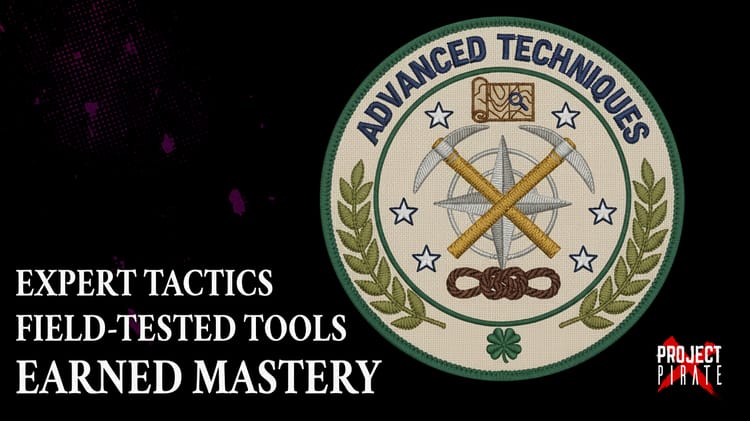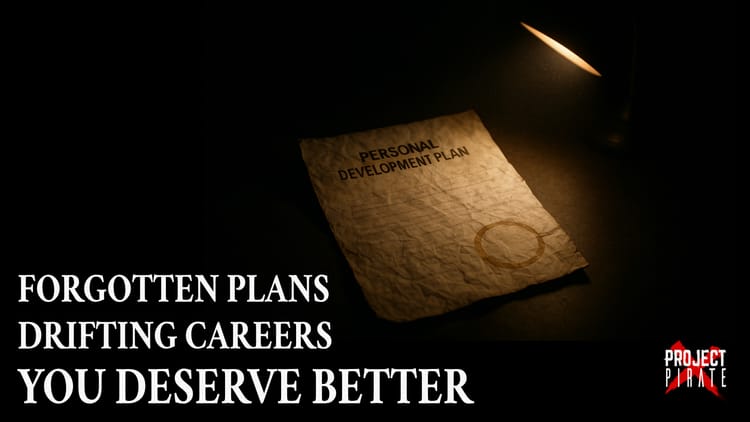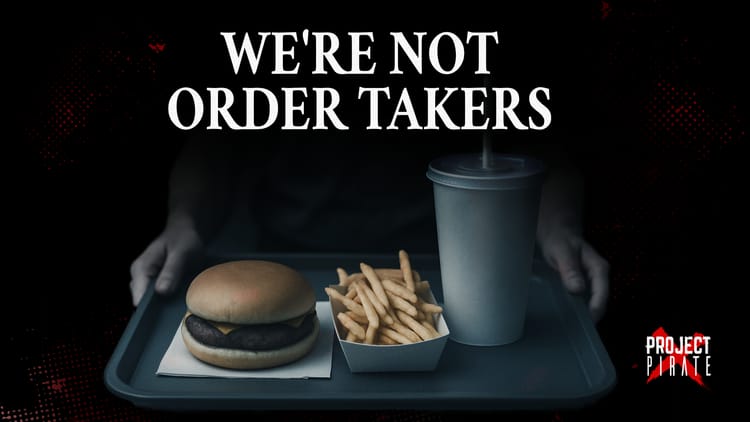Relational Capital: The Currency of Sustainable Delivery
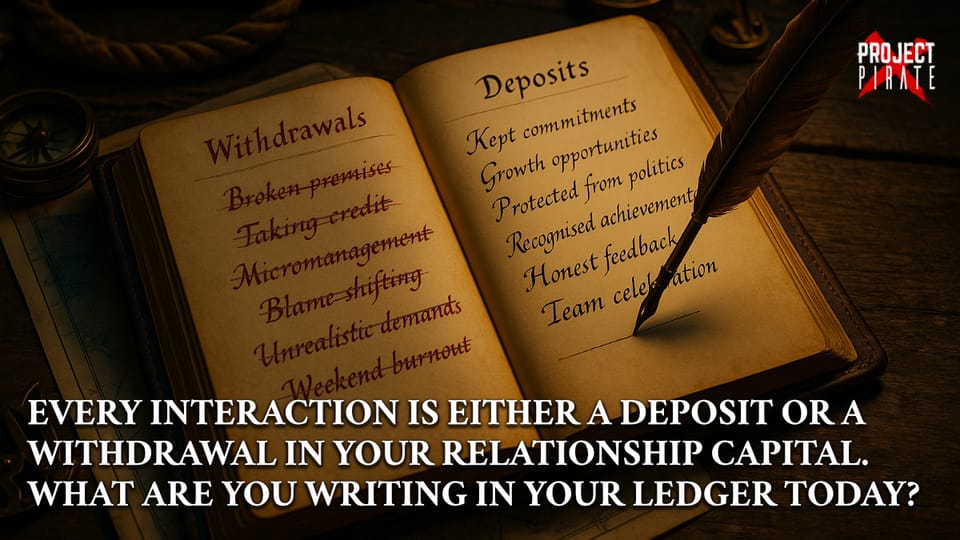
Why the strongest crews are built on trust, not compliance
The Moment of Truth
There's a moment every leader experiences when they discover what their team is truly made of. Not during the smooth sailing of routine delivery, but when the unexpected storm hits and everything seems to be falling apart.
I watched it happen during a critical system migration. Three weeks from go-live, we discovered a fundamental architecture flaw that threatened to derail months of work. The kind of crisis that sends executives into panic mode and transforms team meetings into blame-seeking exercises.
But something remarkable happened instead.
The team didn't scatter or point fingers. They didn't wait for orders or hide behind process. They pulled together, worked through the weekend not because they were pressured, but because they genuinely wanted to solve the problem.
We delivered on time. More importantly, we emerged stronger as a team.
That's when I understood the difference between teams built on compliance and those built on something far more powerful: relational capital.
The New Currency of Leadership
In the evolving landscape of project delivery, a profound shift has occurred. The old model of "command and control"; where teams perform because they have to is giving way to something far more sustainable: "cohesion and collaboration" - where teams excel because they want to.
This evolution isn't entirely new; the concept of "servant leadership" recognised decades ago that true authority comes from serving others' success first, with organisational results following naturally. What we're seeing now is this wisdom becoming essential rather than optional in complex, knowledge-driven work.
Relational capital is the accumulated trust, respect and authentic connection between team members. Like financial capital, it requires intentional investment, generates compound returns and becomes the foundation for future opportunities. Unlike traditional hierarchical authority, which extracts compliance through position, relational capital creates genuine commitment through connection.
But here's the crucial insight: just as wise investors diversify their portfolios, effective leaders invest across their entire crew rather than relying on single relationships. This diversification protects against the inevitable changes - when team members leave, get promoted, or shift roles - while building collective strength that transcends individual dependencies.
The most successful project leaders have learned to think like investors rather than spenders. They understand that sustainable delivery comes not from pushing teams harder, but from building relationships that can weather any storm.
Key Insight: Teams united by shared purpose and mutual respect deliver better results than those driven by pressure alone.
Investment vs. Spending: The Strategic Choice
Every leader makes a fundamental choice about how they'll drive performance. This choice shapes everything from team dynamics to long-term success.
The Spending Approach
We've all seen it: the project manager who treats team members like resources to be optimised rather than people to be developed. Their approach is transactional:
- "I need this done by Friday" (without explaining why it matters).
- "We're behind schedule, everyone needs to work weekends" (solving planning problems with team sacrifice).
- "That's not my problem, just get it done" (abdicating responsibility while maintaining authority).
This spending mindset might deliver short-term results, but it's fundamentally unsustainable. Teams operating under constant pressure experience declining quality, hidden problems, talent drain and fragile delivery that collapses when any team member becomes unavailable.
The Investment Approach
Leaders who build relational capital operate from a different premise. They recognise that their role isn't to spend maximum output, but to create conditions where exceptional performance emerges naturally:
- "Here's why this work matters to our bigger picture" (providing context and meaning).
- "I'll handle the stakeholder pressure while you focus on solutions" (protecting the team's energy).
- "We're facing a challenge - what do you think our options are?" (inviting collaboration rather than demanding compliance).
This investment mindset creates compound returns: self-organising Crews that solve problems proactively, psychological safety that surfaces issues early, voluntary excellence where people take pride in collective success and resilient delivery that adapts quickly to unexpected challenges.
Strategic Truth: Like compound interest; often called the eighth wonder of the world - relational capital creates exponential returns over time. Small, consistent investments in human connection compound into extraordinary Crew performance that far exceeds what hierarchical pressure could ever achieve. 💰
Building Your Relational Capital Portfolio
Like any investment strategy, building relational capital requires understanding how to make deposits, avoid withdrawals and recognise the compound returns that emerge over time. But the key is portfolio thinking - investing across your entire crew creates resilience that no single relationship can provide.
Diversified Investment Strategy
Invest Across All Levels Don't just build relationships with senior Crew members or high performers. Junior developers, business analysts and support staff all contribute unique value and perspectives. When you invest broadly, you create multiple channels for information, support and innovation.
Balance High-Touch and Systematic Investments Some relationships require intensive, personalised attention. Others benefit from consistent, systematic investment through team-wide practices. Like a financial portfolio balancing growth stocks with steady bonds, your relational investments should span both approaches.
Cross-Functional Diversification Build relationships beyond your immediate Crew. Stakeholders, other project managers, technical specialists and support functions all form part of your extended Crew. This diversification protects you from single points of failure and creates a network that can support complex deliveries.
Making Strategic Deposits
Consistency in Commitments Nothing builds trust faster than reliable follow-through. When you say you'll get back to someone by Thursday, do it. When you promise to resolve a resource constraint, deliver. Each kept promise makes a deposit. Each broken commitment - especially when not acknowledged makes a withdrawal.
Protective Leadership Your team needs to know you'll shield them from unnecessary political turbulence. This servant leadership approach recognises that your role is to remove obstacles for your team, not create them:
- Filtering stakeholder anxiety rather than amplifying it.
- Taking responsibility for team failures while sharing credit for successes.
- Challenging unrealistic demands rather than simply passing them down.
- Creating calm in the storm rather than adding to the chaos.
Genuine Investment in Growth People want to know that working with you will develop their capabilities, not just extract their current skills. This means connecting team members with stretch opportunities, providing honest feedback that helps people improve and creating space for experimentation and learning.
Appropriate Vulnerability Authentic leadership requires the courage to be human. This doesn't mean oversharing personal problems, but it does mean admitting when you don't know something, acknowledging your mistakes and expressing genuine uncertainty about complex challenges rather than projecting false confidence. As we explored in "A Crew Mirrors Their Captain", your team inevitably reflects your authentic leadership behaviours - vulnerability creates psychological safety, whilst false perfection breeds defensive communication.
Avoiding Costly Withdrawals
Broken Promises Without Acknowledgment When circumstances force you to change commitments, acknowledge the change explicitly. "I know I said we'd have that resource by Monday, but priorities have shifted. Here's what I'm doing about it."
Credit Theft and Blame Shifting Nothing destroys relational capital faster than taking credit for team achievements or throwing people under the bus when stakeholders apply pressure. Your job is to take responsibility upward and provide support downward.
Micromanagement Excessive oversight signals that you don't trust your team's capabilities. Once you've established clear expectations and provided necessary context, step back and let people do their work.
Investment Principle: The compound returns of relational investment create teams that deliver exceptional results because they genuinely want to succeed together.
The Power of Compound Returns 📈
Teams with strong relational capital exhibit behaviours that traditional project management struggles to achieve through process alone:
Self-Organising Problem Solving When challenges arise, these Crews don't wait for the project manager to assign blame or mandate solutions. They naturally collaborate to understand problems, explore options and implement fixes.
Proactive Communication Instead of hiding problems until they become crises, Crew members with psychological safety raise concerns early. They know their observations will be welcomed rather than punished.
Voluntary Excellence People take genuine pride in their contribution to collective success. They suggest improvements, catch errors, and go beyond minimum requirements not because they're pressured, but because they're invested in the outcome.
Resilient Recovery When setbacks occur, Crews with strong relationships recover faster. They support each other through difficult periods, share knowledge freely and maintain morale during challenges.
Context-Specific Strategies
Building relational capital requires different approaches depending on your situation:
For New Teams: Foundation Building
Create Early Shared Wins Design initial project phases to generate success experiences that the whole team can celebrate together. These early wins build confidence and create positive associations with working together.
Establish Communication Norms Rather than imposing rigid processes, collaborate with the team to establish how you'll communicate during normal operations and crises. This creates buy-in and ensures the approaches work for everyone.
Invest in Understanding Spend time learning about each team member's strengths, motivations, and career aspirations. This strategic intelligence helps you deploy people effectively and provide meaningful development opportunities.
During Crises: When Relationships Become Lifelines
Communicate Purpose, Not Just Pressure Instead of simply passing down stakeholder anxiety, help your team understand why the challenge matters and how their efforts connect to larger outcomes. People can handle pressure when they understand its purpose.
Maintain Unity Avoid language that suggests you're separate from the team's struggle. Use "we" instead of "you" when discussing challenges. Share the burden rather than delegating it.
Provide Air Cover Your job during crisis is to create calm space for your team to do their best thinking and work. This means absorbing stakeholder pressure, securing needed resources, and removing obstacles.
For Long-term Projects: Sustaining Connection 🤝
Plan for Sustainable Pace Resist the temptation to maintain constant urgency. Build recovery periods into your timeline and protect them from scope creep. Your team's energy is a finite resource that must be managed thoughtfully.
Address Friction Quickly In long-term projects, small interpersonal issues can compound into major problems. Address conflicts and communication breakdowns quickly rather than hoping they'll resolve themselves.
Maintain Connection to Purpose Over time, teams can lose sight of why their work matters. Regularly reconnect people to the larger impact of their efforts and celebrate progress toward long-term goals.
Practical Truth: The strongest ships are crewed by people who choose to be there, not those press-ganged into service.
Reading Your Relational Capital Balance
Unlike financial accounts, relational capital doesn't come with convenient statements. Learning to read the signs of relational health requires developing sensitivity to subtle indicators:
Positive Balance Indicators
- Quality of questions in meetings: Teams ask thoughtful questions that advance understanding rather than positioning themselves defensively.
- Speed of problem surfacing: Issues get raised quickly rather than hidden.
- Unsolicited improvement suggestions: People offer ideas because they're invested in collective success.
- Peer-to-peer support: Team members help each other without being asked.
- Response to challenges: The team pulls together rather than fragmenting when surprises occur.
Warning Signs of Declining Balance
- Meeting silence: When people stop volunteering information or asking questions.
- Increased escalation: Team members bringing problems they previously would have solved themselves.
- Defensive communication: People becoming overly careful about how they phrase things.
- Talent flight: Good people choosing to leave, especially citing "culture" concerns.
- Brittle delivery: Over-dependence on specific individuals with no resilience to changes.
The Strategic Advantage
Organisations that consistently build teams with strong relational capital develop competitive advantages that compound over time:
Faster Project Initiation: When people want to work together again, new projects start with existing trust rather than having to build relationships from scratch.
Higher Success Rates: Projects led by people known for building strong teams attract better talent and receive more organisational support.
Innovation Through Safety: Teams with strong relational capital are more likely to experiment, take calculated risks, and learn from failures – the behaviours that drive genuine innovation.
Organisational Resilience: When challenges hit, organisations with diversified relational capital adapt faster because they have multiple strong relationships rather than depending on single key individuals. The departure of any one person, while significant, doesn't collapse the entire network.
True Wealth Management: Like financial wealth management, the goal isn't just accumulation but sustainable growth and protection. A well-diversified relational portfolio creates lasting value that appreciates over time and weathers market volatility - whether that's organisational change, team turnover, or project pressures.
The Project Pirate Way
This philosophy embodies the core Project Pirate principle: "Loyal to No Fleet, United by the Storm." This isn't about rejecting loyalty or operating in selfish isolation - quite the opposite. It means we're not bound by rigid corporate hierarchies or political allegiances that put bureaucracy before people. Instead, we choose our loyalty consciously, uniting with those who share our commitment to genuine excellence and mutual support. When the inevitable storms of project delivery hit, we stand together not because we're ordered to, but because we've chosen to sail alongside people we trust and respect.
But it also brings full circle the servant leadership wisdom that was articulated decades ago - that genuine authority emerges not from commanding others, but from creating conditions where they can flourish. In maritime terms, the most respected Captains aren't those who rule through fear, but those who earn loyalty by serving their Crew's success first.
The strongest Crews aren't held together by rigid command structures or fear-based compliance. They're united by people who choose to weather challenges together through authentic connection and shared purpose.
In modern project delivery, where talented people have options and complex work requires genuine collaboration, the leaders who understand relational capital will build the teams that thrive. They don't just manage projects - they create conditions where exceptional performance emerges naturally because people are genuinely committed to collective success.
Your Choice of Currency 💵
Every leader stands at a crossroads, facing the most consequential decision of their career: how will you choose to generate performance from the people who trust you with their professional lives?
You can spend their energy, enthusiasm and goodwill like cash from a depleting account - pushing for immediate results whilst slowly bankrupting the relationships that make sustainable success possible. This approach might fill your quarterly reports, but it leaves behind organisational wreckage and talented people who'll never work with you again. 📉
Or you can invest.
You can treat your Crew like the diversified portfolio they are - each person bringing unique value, different strengths, varying risk profiles and growth potential. You can make consistent deposits across all relationships, not just the high performers or senior voices. You can protect your investments from market volatility - the organisational storms, political pressures and competitive threats that test every team.
And here's what separates great leaders from merely functional ones: you understand that relational capital, like compound interest, creates exponential returns over time. Einstein reportedly called compound interest the eighth wonder of the world, saying "those who understand it, earn it; those who don't, pay it."
The same principle transforms human relationships in project delivery.
Every small act of trust builds on the last. Every kept promise multiplies your credibility. Every moment you choose to protect rather than expose your Crew compounds into fierce loyalty. Every investment in someone's growth pays dividends not just in their performance, but in how they treat others, creating ripple effects that strengthen the entire network.
But like compound interest, this only works with time and consistency. You can't deposit trust on Monday and expect compound returns by Friday. The magic happens in the accumulation - small, consistent investments that seem insignificant in isolation but create extraordinary results when compounded over months and years.
Leaders who grasp this principle build something remarkable: Crews that don't just deliver projects, but create legends. Teams that don't just weather storms, but emerge stronger from each one. Organisations that don't just survive market changes, but adapt and thrive because their relational portfolio is diversified, mature and generating compound returns.
The mathematics are simple. The choice is yours. 🏴☠️
Your Crew is watching. They're calculating whether you see them as expenses to be managed or investments to be grown. They're measuring whether your leadership deposits compound into something extraordinary or simply extract what little they're willing to give.
What will your relational portfolio statement show a year from now?
Join the Crew - where relationships compound into legends.
